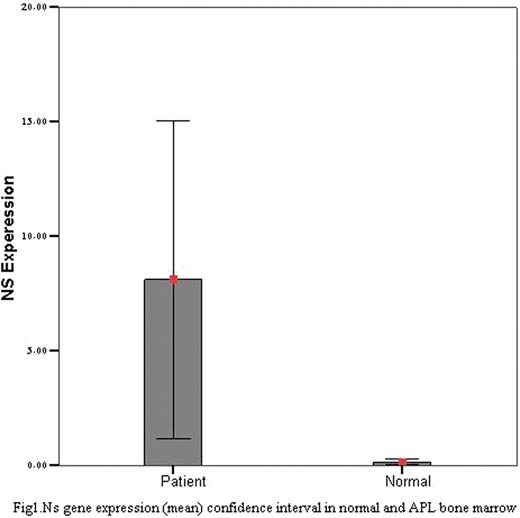Abstract
Abstract 4430
Nucleostemin (NS), a novel p53-binding protein has been shown essential for stem and cancer cell proliferation and implicated in oncogenesis. Nucleostemin expression had been shown in gastric cancer (SGC-7901) cells, human hepatocarcinoma (HepG2) cells, human cervical cancer (Hela) cells, human osteosarcoma (OS-732) cells.
This work designed to study the NS gene expression in bone marrow cells in acute promyelocytic leukemia (APL) patients and in normal bone marrow specimens.
We examined NS gene expression by Quantitative Real Time PCR in bone marrow specimens of 15 cases of APL patients, before treatment and in 4 bone marrow specimens of healthy donors of bone marrow transplantation. In the same samples of bone marrow aspiration morphology of smears was evaluated. Diagnosis of APL was based on morphology and positive PML/RARA in PCR. RT-PCR used to amplify the NS mRNA, and the GAPDH primer sets used for normalizing. For comparison of NS gene expreesion in 2 groups Mann-Whitney U test was used.
15 patients enrolled in this study, 11(73%) newly diagnosed APL and 4(27%) relapsed cases. Mean age of patients was 28.67±9.56 year. NS gene expressed in all bone marrow samples of APL patients. NS gene expressed in normal bone marrow specimens too. NS gene expression in bone marrow of APL patients was significantly higher than normal bone marrows(p value =0.002) Fig 1. There was no significant difference in NS gene expression between newly diagnosed and relapsed APL cases.
According to the results of this study it seems that NS gene expressed in normal marrow. NS expression in adult bone marrow hematopoietic stem cells had been reported in previous reports and it had been shown that NS does not express in granulocytes and B lymphocytes. It seems that stem cells and proliferating cells in the normal marrow are the source of NS expression detected in normal marrow. NS expreesion in bone marrow of APL patients was significantly higher than normal marrow. In these patients before treatment marrow is replaced by undifferentiated blasts and promyelocytes. We concluded that NS expression in these cells were high. It had been shown that NS down regulation may lead to cell cycle exit. High expression of NS in APL patients can be used in future researches for finding new targeted therapies in this disease.
No relevant conflicts of interest to declare.
Author notes
Asterisk with author names denotes non-ASH members.


This feature is available to Subscribers Only
Sign In or Create an Account Close Modal